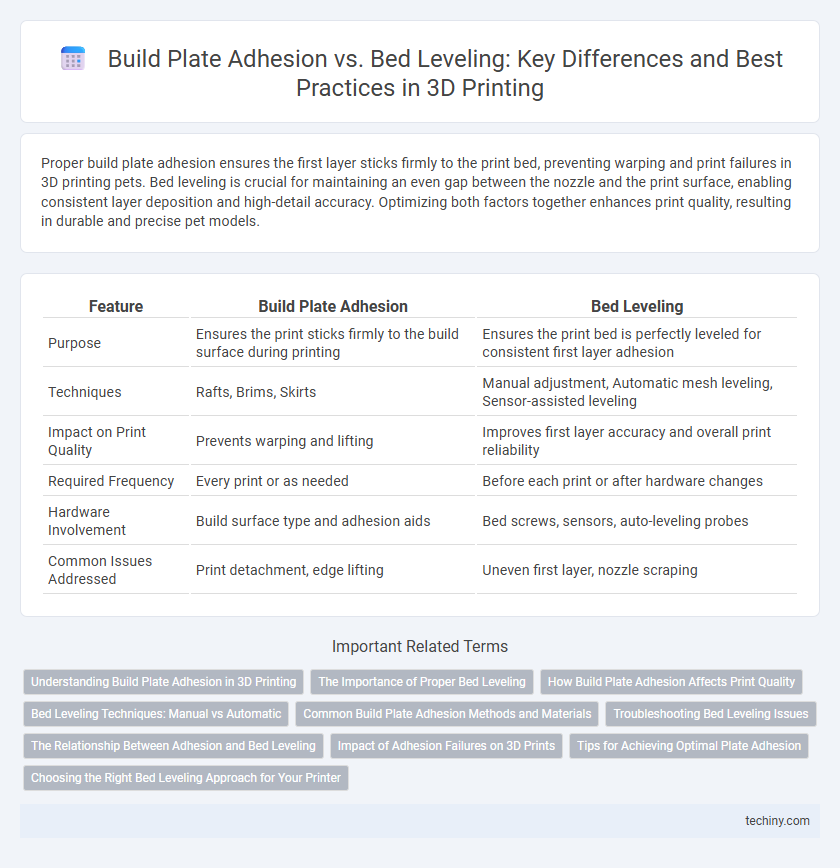Proper build plate adhesion ensures the first layer sticks firmly to the print bed, preventing warping and print failures in 3D printing pets. Bed leveling is crucial for maintaining an even gap between the nozzle and the print surface, enabling consistent layer deposition and high-detail accuracy. Optimizing both factors together enhances print quality, resulting in durable and precise pet models.
Table of Comparison
| Feature | Build Plate Adhesion | Bed Leveling |
|---|---|---|
| Purpose | Ensures the print sticks firmly to the build surface during printing | Ensures the print bed is perfectly leveled for consistent first layer adhesion |
| Techniques | Rafts, Brims, Skirts | Manual adjustment, Automatic mesh leveling, Sensor-assisted leveling |
| Impact on Print Quality | Prevents warping and lifting | Improves first layer accuracy and overall print reliability |
| Required Frequency | Every print or as needed | Before each print or after hardware changes |
| Hardware Involvement | Build surface type and adhesion aids | Bed screws, sensors, auto-leveling probes |
| Common Issues Addressed | Print detachment, edge lifting | Uneven first layer, nozzle scraping |
Understanding Build Plate Adhesion in 3D Printing
Build plate adhesion in 3D printing refers to the ability of the first printed layer to stick firmly to the print surface, which is critical for preventing warping and ensuring print stability. Factors such as surface material, temperature, and use of adhesives like glue sticks or painter's tape significantly enhance build plate adhesion. Proper adhesion improves print quality and reduces the risk of failed prints caused by detachment during the printing process.
The Importance of Proper Bed Leveling
Proper bed leveling is crucial for successful 3D printing, as it ensures the build plate is evenly distanced from the nozzle, promoting optimal build plate adhesion and preventing print failures. Inadequate leveling can cause inconsistent extrusion, leading to warping, poor layer bonding, and potential print detachment. Consistently calibrated beds improve print quality, reduce material waste, and enhance overall printer performance.
How Build Plate Adhesion Affects Print Quality
Build plate adhesion directly impacts print quality by ensuring the first layer firmly attaches to the bed, preventing warping and shifting during the printing process. Poor adhesion can lead to defects such as layer misalignment, gaps, or complete print failure, while well-calibrated adhesion methods like brim, raft, or skirt improve dimensional accuracy and surface finish. Optimizing adhesion techniques reduces print errors and enhances overall structural integrity of 3D printed models.
Bed Leveling Techniques: Manual vs Automatic
Bed leveling techniques in 3D printing significantly impact the quality of prints by ensuring the first layer adheres properly to the build plate. Manual bed leveling involves adjusting screws to achieve an even distance between the nozzle and the build plate, relying heavily on user skill and patience. Automatic bed leveling employs sensors such as inductive, BLTouch, or capacitive probes to measure surface height variations, offering higher precision, repeatability, and ease of use compared to manual methods.
Common Build Plate Adhesion Methods and Materials
Common build plate adhesion methods in 3D printing include using adhesives such as glue sticks, painter's tape, and specialized adhesion sheets like PEI or BuildTak. Materials like blue painter's tape and Kapton tape enhance first-layer grip by creating textured surfaces that improve filament bonding. Proper use of these adhesion aids minimizes print warping and ensures stable layering, directly impacting print quality.
Troubleshooting Bed Leveling Issues
Troubleshooting bed leveling issues is crucial for effective build plate adhesion in 3D printing, as an uneven or improperly leveled bed leads to poor first layer adhesion and warping. Regularly calibrating the leveling screws and using a feeler gauge or sensor to ensure consistent nozzle distance across the build plate improves print quality and reduces adhesion failures. Implementing automatic bed leveling sensors like BLTouch or capacitive probes enhances precision and minimizes manual adjustment errors, facilitating better layer bonding.
The Relationship Between Adhesion and Bed Leveling
Build plate adhesion directly depends on precise bed leveling to ensure the initial layer bonds securely to the printer bed, affecting print quality and success. An uneven bed causes inconsistent nozzle distance, leading to poor adhesion, warping, or failed prints. Proper bed leveling optimizes surface contact, enhancing adhesion methods such as brim, raft, or skirt for stable 3D printing results.
Impact of Adhesion Failures on 3D Prints
Build plate adhesion directly influences the success of 3D prints by ensuring the initial layer firmly sticks to the print bed, minimizing warping and shifting. Poor adhesion often results in print defects such as layer separation, incomplete models, and nozzle clogs, which can ruin entire print jobs. Proper bed leveling creates a uniform nozzle-to-bed distance, but without strong adhesion, even a well-leveled bed cannot prevent print failures caused by material lifting or detachment during the printing process.
Tips for Achieving Optimal Plate Adhesion
Achieving optimal build plate adhesion in 3D printing requires precise bed leveling to ensure the nozzle maintains a consistent distance from the build surface. Utilizing tools such as a feeler gauge or an automatic bed leveling sensor helps create an even first layer, which is crucial for minimizing warping and improving print success rates. Applying adhesion aids like glue stick, painter's tape, or specialized adhesion sheets further enhances the bond between the filament and the build plate.
Choosing the Right Bed Leveling Approach for Your Printer
Selecting the proper bed leveling method is essential for optimal build plate adhesion in 3D printing, as precise leveling ensures the first layer firmly sticks to the print bed, reducing warping and print failures. Manual bed leveling offers control and is cost-effective, while automatic bed leveling sensors, such as BLTouch or inductive probes, provide higher accuracy and convenience for complex or large-scale prints. Understanding your printer model and material requirements helps determine whether a manual adjustment or an auto-leveling system best enhances adhesion and print quality.
Build Plate Adhesion vs Bed Leveling Infographic

 techiny.com
techiny.com